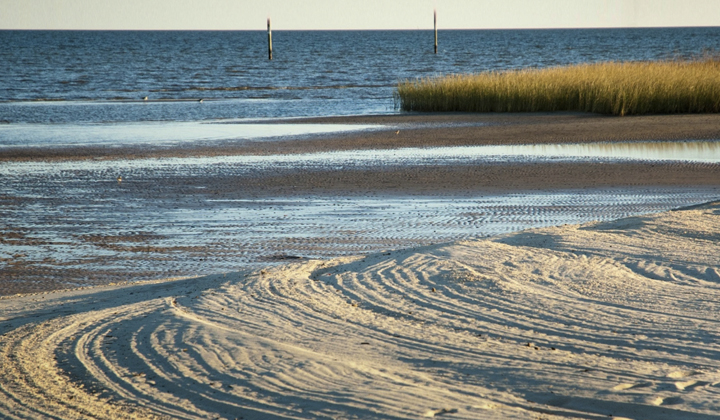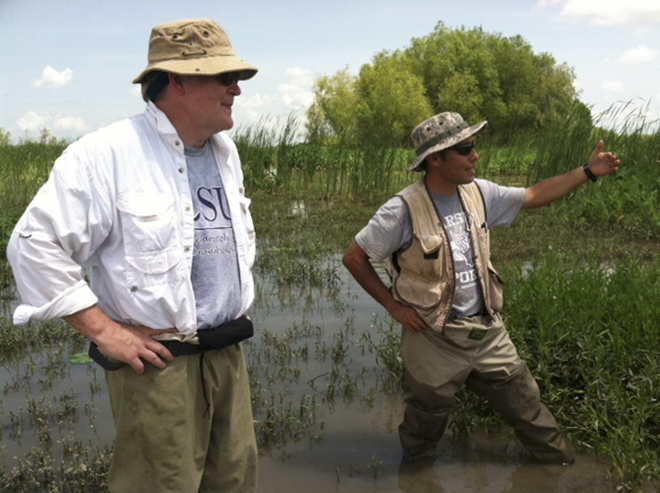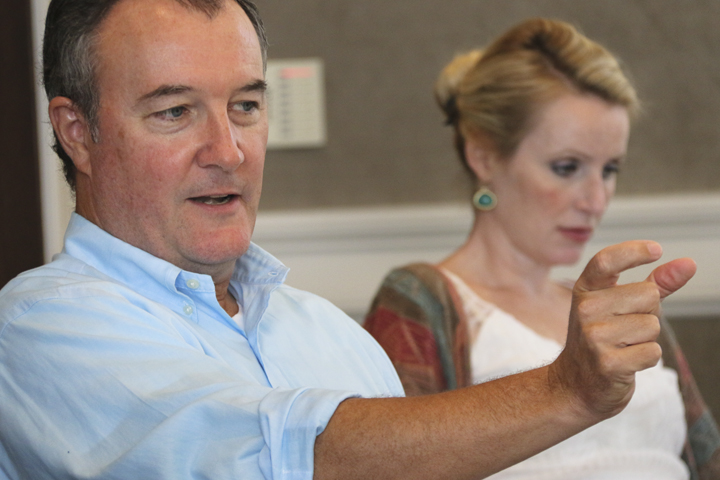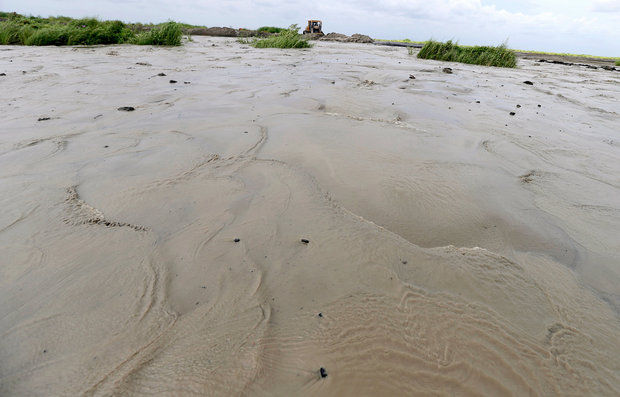DELACROIX, Louisiana – Stanley Encalade, 54, an out-of-work oysterman doing odd jobs on boats along highway 300 running through what’s formerly some of the world’s most fertile oyster territory in this state’s St. Bernard Parish, isn’t buying BP’s insistence that fresh water is to blame for the Gulf’s precipitous drop in oyster hauls over the last four years.
“It’s b*llshit, plain b*llshit,” he says while taking a break from working on a dry docked crab vessel. “That’s what they selling this week, I ain’t buyin like I ain’t been buyin for the last four years – it’s the oil that wrecked my life, the oil. Not water – the oil.”
Encalade’s generations-honed Cajun tongue pronounces “oil” as “earl,” and he takes pride in his heritage among a long line of Cajun fishermen in the Parish.

Stanley Encalade, an out of work oyster fisherman in Delacroix, Louisiana. (Photo: Charles Digges/Bellona)
“I know what I seen in my oyster beds over in Black Bay and it wasn’t no fresh water,” he said, referencing a brackish inlet about 10 kilometers southeast of Delacroix. “It was orange mixed with sticky tar and it’s killed everything and nothing’s taken since. It’s the oil.”
Encalade is no young, green reed to these waters. He owns two oyster boats, the Lady Pamela, and Miss Tallis, which are anchored in Plaquemines Parish, about 20 kilometers northeast of the sunbaked highway in Delacroix, and he has fished oyster for 40 years.
But he’s been out of oyster fishing this season and parts of previous, unable to break even on the lean pickings.
“I used to haul up 70 to 80 sacks a day on my own,” he said. But this year, whose season began in October, he’s hauled up a mere 11. “I can’t do it anymore – it’s too depressing.”
A sack, according to oystermen, weighs anywhere from 80 to 130 pounds, though local fisheries say that, at best, sacks are a sort of estimate to indicate 100 pounds, and the estimates can be imprecise.
Encalade, a two-meter-tall father of eight children ranging in age from 19 to 36, now takes odd jobs to pay the bills. He fixes other peoples’ boats, which sit as fallow as his. A high point in his itinerant employment was a turn on Treme, the hit HBO series on post-Katrina New Orleans, as an extra. ”But I ain’t much cut out for acting – I kinda tell it too straight,” he said, smiling and scratching a pustule on his face he said he had since he helped work oil rescue – like every other area fisherman – after the blowout.

A docked oyster boat Encalade is fixing for another owner in hopes of better seasons to come. (Photo: Charles Digges/Bellona)
“BP sure threw us a curve ball, killed everything in the ocean, and now even the people’s dying. We get’s to watch.”
BP speaks in its own defense
The oil giant responsible for the Deepwater Horizon blowout on April 20, 2010 – which amounted to 4.9 million barrel, 87 day oil geyser and the 1.85 million gallon’s worth toxic Corexit oil dispersant rained upon it – has recently cited Louisiana State scientific data and declared its innocence in the destruction of the Gulf’s second biggest cash crop, whose harvests can be wiped out by fresh water as easily as they can by crude and the oil dispersant Corexit. Oysters need salt water to survive.
An April 12 statement from BP, issued in response to an Associated Press article, and pointed its finger squarely at “Louisiana’s diversion in 2010 of fresh water from the Mississippi River into oyster habitat,” as well as flooding in in 2011. The diversion was ordered as a last ditch effort to clear oil and dispersant out of Louisiana’s ever-dwindling wetlands and marshes – though scientists say it was ill advised.
The evidence, furnished to BP by the state, the statement asserted, “debunked” the idea “that oyster populations in Louisiana were adversely affected by oil or dispersants from the Deepwater Horizon accident […]”
Meanwhile, the lion’s share of seafood safety testing is done at sea by nonprofits like the Louisiana Environmental Action Network (LEAN) in affiliation with the University of Texas and the National Institute for Environmental Health Sciences Center.
How bad is the downturn?
It’s clear from Bellona’s interviews with scientists, fishermen, seafood distributors, and Gulf state Marine resource officials that BP’s stoic rebuttal that the abysmal oyster harvest is not related to its disaster must be taken with the grains of salt the company is insisting were washed out of the oyster beds.
By this year, the oyster harvest Gulf-wide is hovering around one quarter to one third of what it was prior to the BP spill, Chris Nelson, owner of Bon Secour Fisheries, Inc – which buys oysters from all five Gulf states – told Bellona in a telephone interview.
“There’s just nothing out there,” he said. “We’ve had barren spells before, especially in the 80s and 90s but they’re always cyclical – this is like there’s something chronic out there in the water that’s just preventing things in areas that were once abundant from taking.”

Oyster shells with which the state government and private fishermen are hoping to create new oyster beds, or ‘spats’ to improve future harvests. (Photo: Charles Digges/Bellona)
He said that fresh water inundations tend only to impact oyster harvests for a season, sometimes less, and that fresh water alone couldn’t account for the ongoing downward spiral “which is probably the longest we’ve ever seen.”
What the dreadful harvests mean in numbers are that Louisiana’s public reefs produced about 3 million to 7 million pounds of oyster meat a year prior to BP’s catastrophe, according to figures reported by AP.
Nelson said production in 2010 dropped by some 2 percent, but by the 2011 and 2012 seasons, “it was clear things were really going off a cliff.”
Oyster production in 2012 saw a free-fall to 563,100 pounds (255,417 kilograms). Then in 2013, the figures climbed to 954,950, Nelson said that was a decent bounce, but still was only a third of pre-2010 production rates.
Where the plunging harvest is more visible is in the dollars and cents, said Nelson. Prior to Hurricane Katrina in 2005, prices were holding steady at about $25 a sack. After the fabled nightmare storm hit, followed shortly by the smaller Hurricanes Gustav and Ike in 2008, sack prices rose to about $30.
After the spill, however, the short supply and variability in sack size and quality, Nelson said he is having to persuade his customers to pay from $45 t0 $60 per sack.
“That is a rough sell and a huge increase, but we just don’t have the harvest volume to go any lower,” he said.

The rope metallic droop of an empty oyster net on a dry docker fishing boat in Hopedale, Louisiana. (Photo: Charles Digges/Bellona)
Gulf academics tread carefully
In the local academic community, the oil vs. water debate is one in which scientists can be heard taking out scales to very carefully weigh their words.
In brief, results that would contradict the findings of BP – which still holds the status of a monarchy in the local imagination, comprised of both of happy courtesans and vassals as well as rebellious rabble at the gate – stands to lose a shirt full more of money in the currently stalled $7.8 billion damage suit, whose case papers are yellowing in a New Orleans Federal Courtroom.
Most people on the Gulf Coast with an degrees behind their name are not anxious to find themselves on the wrong end of a potential legal meat-grinder.
Most fertile oyster beds nearly destroyed
The Louisiana corner of the Gulf of Mexico has in the past accounted for about half of the Gulf’s oyster harvest and a third of overall US production because of the usually rich larvae-bearing currents, Dr. Thomas Soniat, an oyster biologist with the University of New Orleans, told Bellona.
Oyster larvae, whose lifecycle is about two weeks, are swept by currents that round the southern tip of the Gulf’s Chandeleur Islands and nestle along Louisiana’s east coast substrates, or oyster beds, within its rich wetlands.
Within the first days of the spill, the Chandeleur Islands, some 15 kilometers north of BP’s runaway Macondo well, were some of the most oil and dispersant soaked areas in the Gulf.
Whether any oyster larvae could have been contaminated in this stew of oil and dispersant as they rode the currents through Chandeleur Sound before settling in beds in eastern Louisiana is something Dr Soniat told Bellona still remains unknown.

LSU’s Dr. Eugene Turner says the BP oil spill reduced the total area of Louisiana’s wetlands by three times between 2010 and 2013. (Photo: Matthew Preusch/Gulf Restoration Network)
Dr Eugene Turner, a wetlands specialist at Louisiana State University’s School of the Coast and Environment, said substrates usually consist of oyster shell beds.
But encroachment upon Louisiana’s wetlands – which reduced in area by three times over the first three years after the spill, according to his research – have necessitated building limestone, brick and even cement substrates for the larvae to take root, or “set” as fishermen call it. Some set, some don’t, and the why is a source of fierce debate.
Birds pointed to hydrocarbons in oyster territory
While Dr Tuner has often been cast in local media reports as a proponent of the BP fresh-water-only theory, his research has been far more nuanced, taking into account all variables, and he told Bellona outright that: “No one here is saying there was zero impact from the oil.”
Because the wetlands and barrier islands like the Chandeleurs were critical stopovers for migratory birds, Dr Turner told Bellona that studies LSU conducted on migratory loons, who feed near oyster beds, “showed signatures” of polycyclic aromatic hydrocarbons – or PAHs, signs of oil – in oyster habitats. Dr Turner concluded that these PAH signatures were most likely due to the loons’ food sources.
This, said DR. Turner, plus an uncharacteristic lack of insect life in wetlands and oyster habitats noticed two years after the spill, led to deeper investigations of what lay beneath the wetlands and the oyster beds.
“The evaporation of some very volatile stuff, PAHs that had slipped in under the oil booms, was noticed,” he said. “The oyster harvests occur quite deep, and it’s very volatile down there.”
The research also revealed in the areas studies that PAH levels were several times what Dr Turner said were normal background levels, and that “it will take decades or more to get back to those levels.”
The normal background PAH levels are set by the usual organic interaction occurring from crude releases making it to short that are routinely released by any of the 40,000 oil platforms, operating or not, in the Gulf.

Oil booms didn’t prevent oil and Corexit from oozing into wetlands and oyster habitat, say fishermen. (Photo: Matthew Preusch/Gulf Restoration Network)
Yet, Dr Turner also said LSU studies showed that organisms similar to oysters were grown in high PAH level habitats where able to thrive as if the PAHs weren’t there at all, presenting something of a conundrum, but one that he said needs further study.
The fresh water theory also holds some water
There also is evidence to suggest that the fresh water inundations are not off-base. The 2010 Mississippi River diversion referred to in the BP statement was, said Dr Turner “a move that those who knew better would not have undertaken,” because of the ravages the fresh water visited on Louisiana’s oyster harvesting areas.
Later, in 2012, the Bonnet Carre Spillway was built in New Orleans to alleviate the 2011 flooding referenced by the April 12 BP statement.
Melissa Scallan of the Mississippi Department of Marine Resources told Bellona the spillway decimated her state’s oyster haul for 2012, reducing to a mere 65 sacks against the previous year’s 43,772. When measured against Mississippi’s take of 385,949 sacks in the 2009 season, though, Mississippi’s 2011 take was a pittance.
Scallan was thus on the fence when considering point blank whether the BP spill or the inundations did more damage to Mississippi’s harvest.
“Obviously the oil played a big role, but the water is important to,” she said a little hesitantly. “I guess we will not know for a long time.”
Blocked state environmental information?
In conversation with Bellona, Nelson was surprised by the LSU research cited by Dr Turner. Very little of it has been made public.
Nelson also noted that the oyster blight is not general throughout the Gulf. Some areas that have produced in the past are still producing, where other areas that could have been counted on for consistently abundant harvests are “dead zones.”
These dead zones, he said, correspond to areas that were hit by BP oil and dispersant, and said that an ongoing PAH presence in oyster habitats, especially in the Gulf’s previously most productive area, could account for the rock bottom harvest rates for the last four years.
But Nelson said that “those who would know aren’t telling me whether it’s fresh water inundation, or BP oil and dispersant or even something else.”
The ones who presumably know, said Nelson, are officials at the Louisiana Department of Wildlife and Fisheries, which has been conducting a so-called Nation Resource Disaster Assessment (NRDA) on the public reef oyster fishing areas since days after the Deepwater Horizon blew, and thus has wide discretion over what it reveals and keeps close to the vest.

Louisiana Wildlife and Fisheries officials are unable to comment on the condition of many oyster habitats that fall under a National Resources Disaster Assessment (NRDA) ,restricting public knowledge about the environment. (Photo: Jonathan Henderson/Gulf Restoration Network)Nelson, fishermen and local activist groups complain that the long running study should have revealed at least some tangible results by now, and say the agency is purposely stymieing the flow of information on the local environment.
Nelson routinely tries to get small clues out of them and says “it’s like there’s some sort of gag order in place over there.”
“We don’t know if they’ve found something horrible that will kill oysters in the Gulf forever or if it’s a problem that will resolve relatively soon,” he said. “But the point is we don’t know and they won’t say.”
After repeated calls and emails from Bellona over a three-day period, Wildlife and Fisheries responded with an emailed statement reading that, “Impacts to Louisiana’s natural resources as a result of the Deepwater Horizon Oil Spill continue to be investigated as part of the Natural Resource Damage Assessment Process set forth under the Oil Pollution Act of 1990. We do not yet know the full extent of the damages to the resources (including the impacts to oysters.)”
The statement added that the agency has “documented significant reductions in reproductive success of oysters on our public seed grounds,” and acknowledged that, “[w]hile investigations into the direct cause of low spat [oyster bed] production continues through the Natural Resource Damage Assessment (NRDA) process, the low oyster spat [production] coincides with the timing and location of the Deepwater Horizon disaster.”The agency implied that it wasn’t under any instructions not to release information, writing that the NRDA trustees “continue to actively investigate impacts to oysters as a result of the spill and they have and will continue to release study plans developed over the course of the spill.” The statement provided a link to the various study plans Wildlife and Fisheries has under consideration for each of the impacts it is studying under the NRDA. Nelson nevertheless ironically noted that prior to what seems to be one of Wildlife and Fisheries first pubic statements, the agency’s personnel had been deflecting reporters’ inquiries to him, “as if I know something they don’t.”
Fishermen see oil not water
Fifty-eight-year-old oyster and shrimp fisherman George Barisch, who is also president of the United Commercial Fishermans’ Association, gave some credence to the fresh water notion – though not much. He’s been oyster fishing since he was nine-years-old, on a three generation leased 35-acre plot, and he’s no stranger to fresh water inundations.
“Mother nature’s a bitch – she’ll give, take away, and give again,” he said. “There’s always the fresh water cycle, but the beds always come back.”
But, for his beds, this hasn’t happened since 2010.
He told Bellona that his legacy oyster bed in the Louisiana Marsh’s Caraco Bay was destroyed by oil and Corexit, despite promises by BP not to dump it’s toxic dispersant in Chandeleur Sound between the Chandeleur Islands and Louisiana’s east coast.
“Another lie,” he said of the Corexit dumps.
“In my case, BP took away and mother nature can’t pay their debt – what killed my oysters was oil and Corexit, not fresh water.”

George Barisch testing the safety of oysters near Shell Beach in Yscloskey, Louisiana. (Film still courtesy of the Louisiana Environmental Action Network)
Since then, he’s down a whopping 93 percent in his oyster take since before the spill. Where routinely he would book some 4,000 to 6,000 sacks per season with Nelson’s Bon Secour prior to 2010, he said he hasn’t raised even 600 marketable sacks in the four years since the spill. The rest of his beds are contaminated by oil and dispersant.
“What ever else is left in my beds is covered with such unspeakable nastiness that I can’t possibly bring sell it on the market,” he said. “God forbid somebody gets sick and dies and it gets traced to my product.”
Sacks are typically labeled in detail, with dates of the catch, or “land,” the vessel and the captain.
But this is far from his worries: “My main issue is that none of my leased plots have any babies coming up – I;m broke.”
The nightmare will not go away
Encalade is involved in ongoing litigation with BP, but like most, is not hopeful for any settlement. He passed on earlier offers of $30,000, $40,000 and then $50,000.
“Those are nothing but an insult,” he said. “For a life’s work that I can’t do no more? For work I’ve been doing since before I could read? It’s a g*ddamned insult.”
He and his 27-year-old son are currently represented in the $7.8 billion class action damage suit in New Orleans he said, but that’s not paying any bills.
“Sometimes at night, I fall asleep feeling like I’m in the cabin of my boat,” he confides. “The radio will squawk and I’ll talk back, tell ‘em I’m doing good with 60 or 70 sacks for my trip.”
It’s one of those dreams that goes one, he says, staring off into the heat shimmer rising from the asphalt and gravel and making the far off willows look like they’re submerged in water.
“It’s a dream I’m sure I’ll wake up from and find out the whole nightmare of everything that’s happened since the BP spill is just all that – a nightmare.” his
He lifts his cap from his head and wipes away sweat while staring at his work boots, contemplating that fantasy. “Then I wake up, and find out it’s no nightmare,” he says.
“It’s right here.”
This is the fourth in a series of article Bellona is producing on the aftermath of the Deepwater Horizon spill.














